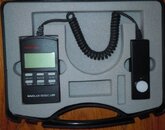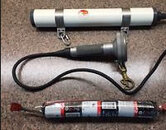Bobby
Contributor
This is from a thread that I responded to a question. It might be helpful for others so I posted it here where it is more easily found.
Lux is the measurement of the amount of light that reaches a specific distance and angle. The problem is that there is not a set criteria for the Lux measurement like there is for Lumen measurements. Just saying a measurement at 1 or 2 meters does not even begin to get a measurement that can be compared with another. A couple of millimeters distance difference or a degree of angle difference will throw the measurements of considerably. We haven't even began to discuss tuning and accuracy for the meter itself. Lux meters can be bought for around $100 US however their accuracy leaves a lot to be desired. The Lux meter we use is on the upper end of the cost side however delivers high end accuracy.
We have built a Lux "Box" that allows us to take accurate measurements of our and other lights. We don't publish these numbers because they are meaningless for comparison with other manufacturers. It allows us to check our products performance with a repeatable number that is useful to us internally. It is easy to boost the numbers we get by shaving a few millimeters off the length of the box to shorten the measurement distance or lower them by making the box a little longer. Repeatable numbers are what is useful to us internally.
We could build a Luminous Sphere for a little over $1500 US however our accuracy would not be close to what is required. To get the needed accuracy the starting point for a sphere is around $50K, which we definitely can't afford. So we use conservative LED manufacturers Lumen numbers, from a manufacturer calculation sheet, that allow us to plug in variables that are adjusted for how our lights are used. There are some manufacturers that inflate their numbers and/or use spec sheets that are more marketing material than real numbers, however most of the quality manufacturers today use conservative Lumen numbers. Again though, the best way to compare lights is to take them on a demo dive.
As I have always said the best way to know if a light fits your needs is to test dive it. That is why we encourage our dealers to have demo units, which almost all of them do. Optics play the biggest role in the beam angle and quality. You can have two lights with one putting out 1K Lumen and the other 2K Lumen that give the same Lux reading at a set distance due to the beams that their optics produce. The 1K would need to be focused down to a light saber type of beam with no peripheral light while the other beam would be wider and more dispersed. Even if all the manufacturers sent their lights out to be tested by an independent facility, to have direct comparison, it would only give a piece of the needed information. Our 10K Lumen video light puts out almost 3 times as much light as our highest output primary, however measures a lot less Lux due to the wide video beam. Having the right beam to fit the need is what is important. If you have a super tight beam with no peripheral light it is harder to see around you, a too wide or dispersed beam won't penetrate far enough. Having multiple power settings is helpful with varying conditions or dive requirements. There are a lot of factors, when discussing the beam, that are important in making a decision.
Now after talking so much about the light output and the beam, which is important, it is also important to keep in mind that it is not the only thing. Quality of parts and manufacture, innovation, reliability, warranty, and service are a few more things that are also equally as important, IMHO. If the light needs to be serviced or repaired where does it have to be sent? We have established repair facilities in Europe and Australia to support our customers outside the US. They have factory training to ensure that our standards are maintained. I believe that the difference in the details is what sets one company apart from another.
Bobby
Lux is the measurement of the amount of light that reaches a specific distance and angle. The problem is that there is not a set criteria for the Lux measurement like there is for Lumen measurements. Just saying a measurement at 1 or 2 meters does not even begin to get a measurement that can be compared with another. A couple of millimeters distance difference or a degree of angle difference will throw the measurements of considerably. We haven't even began to discuss tuning and accuracy for the meter itself. Lux meters can be bought for around $100 US however their accuracy leaves a lot to be desired. The Lux meter we use is on the upper end of the cost side however delivers high end accuracy.
We have built a Lux "Box" that allows us to take accurate measurements of our and other lights. We don't publish these numbers because they are meaningless for comparison with other manufacturers. It allows us to check our products performance with a repeatable number that is useful to us internally. It is easy to boost the numbers we get by shaving a few millimeters off the length of the box to shorten the measurement distance or lower them by making the box a little longer. Repeatable numbers are what is useful to us internally.
We could build a Luminous Sphere for a little over $1500 US however our accuracy would not be close to what is required. To get the needed accuracy the starting point for a sphere is around $50K, which we definitely can't afford. So we use conservative LED manufacturers Lumen numbers, from a manufacturer calculation sheet, that allow us to plug in variables that are adjusted for how our lights are used. There are some manufacturers that inflate their numbers and/or use spec sheets that are more marketing material than real numbers, however most of the quality manufacturers today use conservative Lumen numbers. Again though, the best way to compare lights is to take them on a demo dive.
As I have always said the best way to know if a light fits your needs is to test dive it. That is why we encourage our dealers to have demo units, which almost all of them do. Optics play the biggest role in the beam angle and quality. You can have two lights with one putting out 1K Lumen and the other 2K Lumen that give the same Lux reading at a set distance due to the beams that their optics produce. The 1K would need to be focused down to a light saber type of beam with no peripheral light while the other beam would be wider and more dispersed. Even if all the manufacturers sent their lights out to be tested by an independent facility, to have direct comparison, it would only give a piece of the needed information. Our 10K Lumen video light puts out almost 3 times as much light as our highest output primary, however measures a lot less Lux due to the wide video beam. Having the right beam to fit the need is what is important. If you have a super tight beam with no peripheral light it is harder to see around you, a too wide or dispersed beam won't penetrate far enough. Having multiple power settings is helpful with varying conditions or dive requirements. There are a lot of factors, when discussing the beam, that are important in making a decision.
Now after talking so much about the light output and the beam, which is important, it is also important to keep in mind that it is not the only thing. Quality of parts and manufacture, innovation, reliability, warranty, and service are a few more things that are also equally as important, IMHO. If the light needs to be serviced or repaired where does it have to be sent? We have established repair facilities in Europe and Australia to support our customers outside the US. They have factory training to ensure that our standards are maintained. I believe that the difference in the details is what sets one company apart from another.
Bobby





